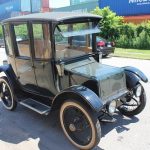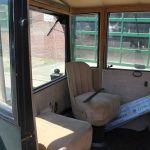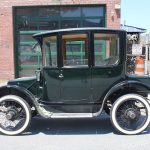1916 Rauch & Lang BX7
The Rauch & Lang Carriage Company was an American electric automobile manufactured in Cleveland, Ohio, from 1905 to 1920 and Chicopee Falls, Massachusetts, from 1920-1932.
In 1911, the Rauch and Lang Electric was voted the most popular car in San Francisco and Minneapolis and a year later, worm drive was introduced. A Rauch & Lang advertisement penned by Albert Lasker of the Lord & Thomas Advertising Agency stated:
“Again has the Rauch and Lang electric asserted its premiership as Society’s chosen car. The success of the new worm drive has been immediate.
“This new feature means continued leadership in driving quality just as the beautiful body lines, rich finish and ultra refinement in every detail have always marked supremacy of Rauch and Lang construction. They are enthusiastic because the Rauch and Lang Straight Type Worm Drive (top mounted), which is superior to all others, means a greater than ever all ’round efficiency, a silence that is manifest, a power economy hitherto unknown and a driving simplicity that appeals to the most timid women. The Rauch and Lang is the highest priced automobile on the market. Its value is readily apparent to those who seek in a car artistic and mechanical perfection.”
Later that year they were sued by their cross-town rivals, the Baker Electric Vehicle Co., for infringing upon Baker’s patented drivetrain.
In 1912, 356,000 passenger cars were produced in the United States, and towards the end of the year, Charles Rauch, the founding father of Rauch & Lang, passed away. On November 26, 1912, the board of directors elected Charles C.F. Wieber president and general manager of the Rauch and Lang Carriage Company. Charles E.J. Lang became vice-president-treasurer and F. W. Treadway the firm’s new secretary. It was during this time that both Lang and Rauch moved their families to the Eastside of Cleveland, building large mansions on the exclusive Euclid Avenue, also known as Millionaire’s Row.
The October 23, 1913, issue of the Automobile announced that Rauch and Lang had introduced a radically new drive principle, the bevel gear transmission. They also introduced the dual control coach, a five-passenger, $3200 electric sedan that could be driven from either the front seat, the rear seat, or both, a safety switch deactivated the forward controls if the revolving front seat was in any position other than forward.
A period Rauch & Lang ad boasted: “Whatever your ideas today, you are certain to come to the conclusion, sooner or later, that an enclosed automobile like the Rauch & Lang Electric combines all the desirable features and eliminates all the well-known annoyances and much of the expense incident to gasoline cars.”
The introduction of Charles Kettering’s self-starter in 1912 marked the beginning of the end for the electric automobile and by 1915 their share of the burgeoning automobile marketplace had fallen dramatically. Despite their earlier lawsuit, Cleveland’s two electric vehicle manufacturers decided to merge, hoping that by streamlining their engineering and manufacturing operations, they might survive.
On June 10, 1915, the Automobile announced the merger, and the resulting firm, the Baker, Rauch & Lang Co. was capitalized for $2,500,000. The officers were: Charles C.F. Wieber, president; Frederick R. White, first vice-president; Charles E. J. Lang, second vice-president; R. C. Norton, treasurer; G. H. Kelly, secretary; F. W. Treadway, counsel. Fred R. White and Rollin C. White, two of the owners of the White Motor Co., were early investors in Baker, and as such were represented on the new Baker, Rauch & Lang Co.’s board of directors.
It soon became apparent that the days of the electric car were numbered and despite both firm’s previous success, a decision was made to look for additional products to produce in their large Cleveland factories.
As early as 1902, Walter C. Baker and Justus B. Entz were independently searching for methods to simplify the operation of the motor vehicle. Baker concentrated his efforts on the electric vehicle, Entz on the electromagnetic transmission, a device that used a magnetic field to drive a propeller or driveshaft. By varying the intensity of the field, a vehicle could go faster or slower without using a clutch. Baker purchased the rights to the Entz patents in 1912, and licensed them to R.M. Owen & Company, the producer of the Owen Magnetic, a gasoline-engined car that utilized an Entz transmission.
It was decided that Baker, Rauch & Lang would produce the Owen Magnetic in Cleveland, so in December 1915, they absorbed R.M. Owen & Co. and relocated it to Cleveland. Raymond M. Owen became a vice-president of Baker, Rauch & Lang and was placed in charge of sales for the Owen Magnetic whose drivetrains were built in the former West 83rd Street Baker plant, the coachwork in the former Rauch & Lang facilities.
The new vehicle attracted the attention of the General Electric Company, and in 1916 they contributed $2,500,000 to the venture which increased Baker, Rauch & Lang’s capitalization to $5,000,000. In return, General Electric was given exclusive contracts for the vehicle’s electrical components and got three seats on their board of directors.
The Owen Magnetic proved popular and was available in nine versions, four on a 29 hp 125-inch wheelbase and five on a 34 hp 136-inch wheelbase – all powered by a six-cylinder gasoline motor. Rauch & Lang’s coachwork was among the finest available, and the attractive cars featured styling similar to that of the finest European chassis. The cars were priced from $3100 to $5700 and were owned by many celebrities including: Enrico Caruso, John McCormack, Arthur Brisbane and Anthony Joseph Drexel Biddle.
Comedian, Tonight Show host, and serious automotive collector, Jay Leno, owns a 1917 Owen Magnetic and wrote about it in his Popular Mechanics column of August 13, 2002: “The engine’s only job is to turn the magnetic field, which then turns the generator, which runs the rear wheels. It’s not a hybrid, it’s driven by a conventional engine. It was an automatic transmission 30 years ahead of its time.”
Baker, Rauch & Lang built most of the Owen-Magnetic’s coachwork, however in 1916-1917 a small series of open sports tourers were built by Holbrook that featured distinctive flat-topped and angled front and rear fenders.
Read more about Panteras here: http://en.wikipedia.org/wiki/Rauch_and_Lang




